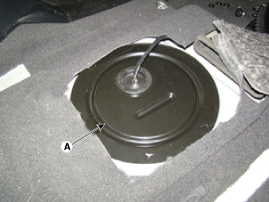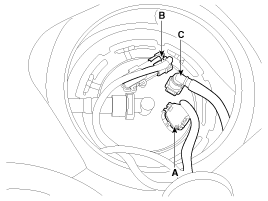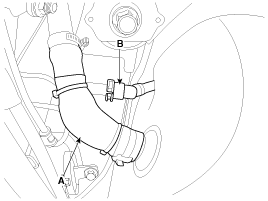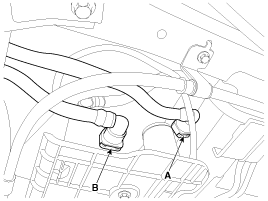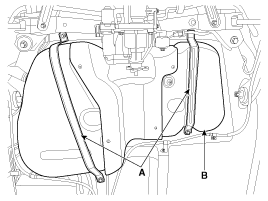 Kia Sorento: Fuel Tank Removal
Kia Sorento: Fuel Tank Removal
| 1. |
Release the residual pressure in fuel line.
(Refer to the Fuel Delivery System - Repair Procedures - "Release
Residual Pressure in Fuel Line")
|
| 2. |
Remove the rear seat assembly.
(Refer to Body - ŌĆ£Rear Seat Assembly")
|
| 3. |
Remove the fuel pump service cover (A).
|
| 4. |
Disconnect the fuel pump connector (A) and the fuel tank pressure
sensor connector (B).
|
| 5. |
Disconnect the fuel feed tube quick connector (C).
|
| 6. |
Remove the rear - LH wheel & tire.
|
| 7. |
Lift the vehicle and support the fuel tank with a jack.
|
| 8. |
Remove the center & rear muffler assembly.
(Refer to Engine Mechanical System - ŌĆ£MufflerŌĆØ) [4 WD]
|
| 9. |
Remove the propeller shaft.
(Refer to Driveshaft and axle - ŌĆ£Propeller ShaftŌĆØ) [4WD]
|
| 10. |
Disconnect the fuel filler hose (A) and the ventilation tube quick-connector
(B).
|
| 11. |
Disconnect the ventilation tube quick-connector (A).
|
| 12. |
Disconnect the vapor tube quick-connector (B).
|
| 13. |
Remove the fuel tank (B) from the vehicle after removing the fuel
tank band (A).
|
 Release Residual Pressure in Fuel Line
Release Residual Pressure in Fuel Line
Whenever the high pressure fuel pump, fuel pipe, delivery pipe,
or injector is removed immediately after shutting off th ...
 Fuel Tank Installation
Fuel Tank Installation
1.
Install in the reverse order of removal.
Fuel tank band installation
bolt:
44.1 ~ 58.8 N.m (4.5 ~ 6.0 kgf.m, 32.6 ~ 43.4 lb-ft)
...
See also:
Parking Brake Cable Removal
Parking brake pedal Type
1.
Turn ignition switch OFF and disconnect the negative (-) battery
cable.
2.
Remove the crash pad lo ...
Multimedia Jack Circuit Diagram
...
SS-A Solenoid Valve(ON/OFF)
SS-A solenoid valve is attached to the valve body and is an on/off solenoid
valve that is used to change gears.
SS-A Solenoid valve(ON/OFF) is installed at valve body.
...
Copyright ® www.ksmanual.com 2014-2025

